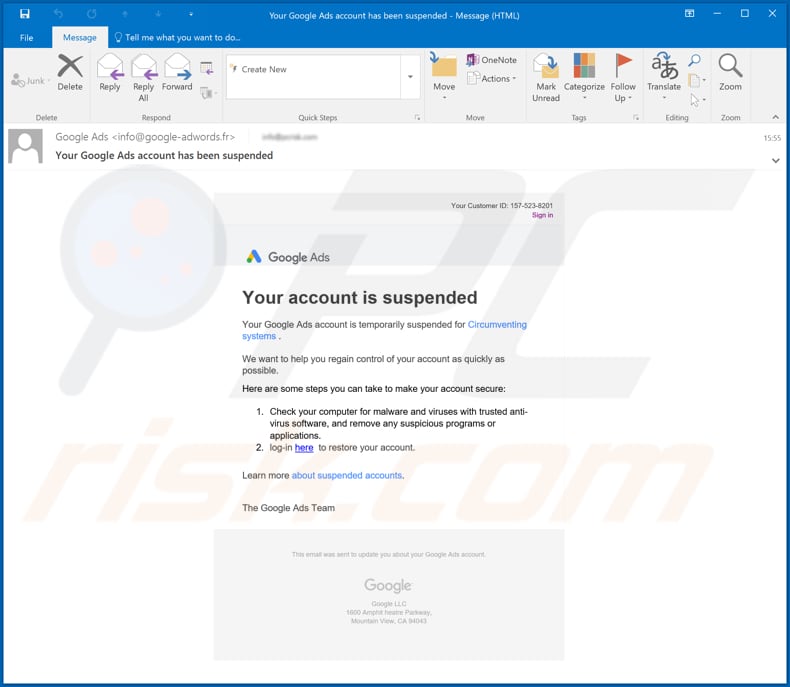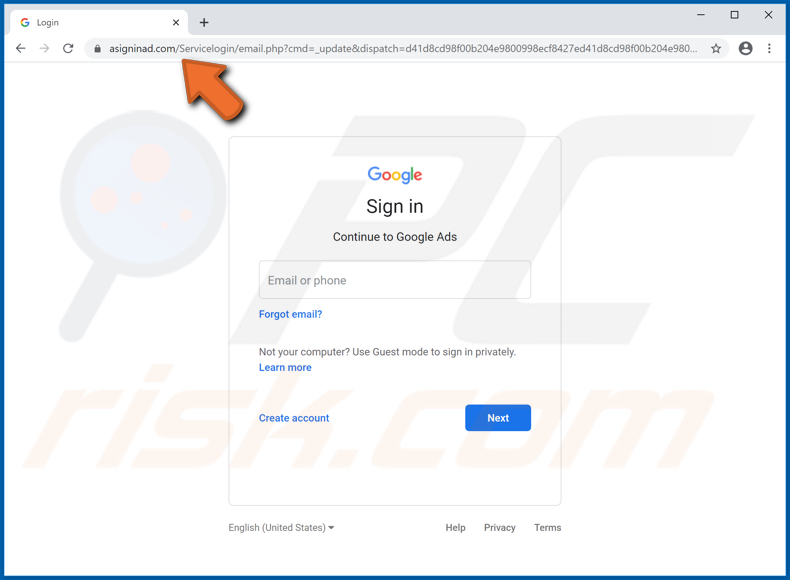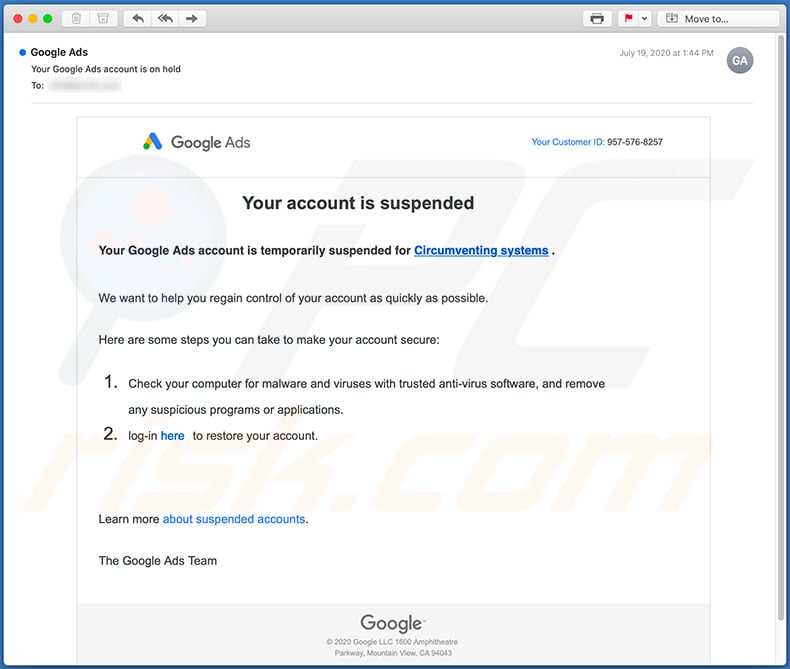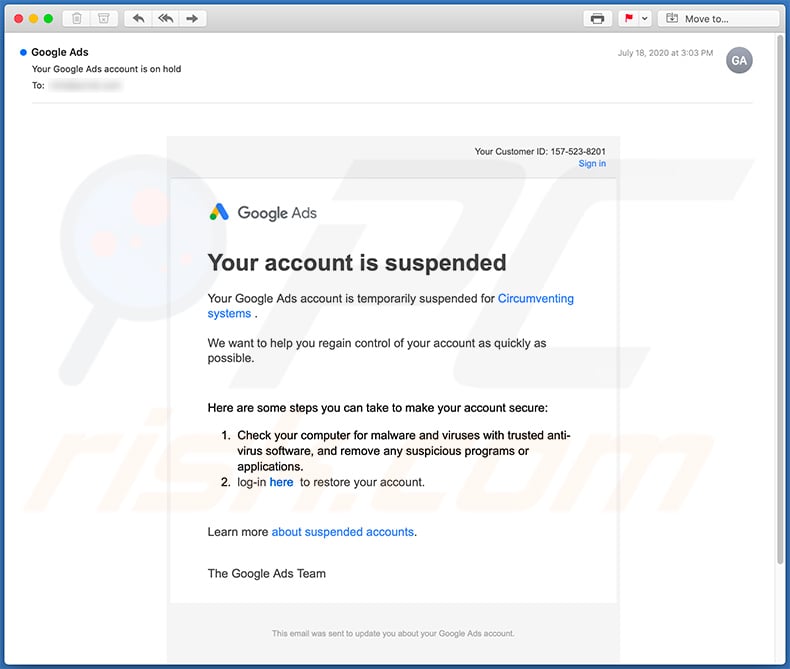Avoid the "Your Google Ads account has been suspended" phishing email
Phishing/ScamAlso Known As: Your Google Ads Account Has Been Suspended spam
Get free scan and check if your device is infected.
Remove it nowTo use full-featured product, you have to purchase a license for Combo Cleaner. Seven days free trial available. Combo Cleaner is owned and operated by RCS LT, the parent company of PCRisk.com.
What is "Your Google Ads account has been suspended"?
Phishing emails such as this are often sent by cyber criminals who attempt to deceive unsuspecting recipients into providing private, sensitive information. In this particular case, they send emails claiming that the recipients' Google Ads accounts have been suspended and urge them to restore the accounts by logging in via a deceptive website.
Note that Google has nothing to do with this email or the bogus website. Therefore, you should ignore this phishing scam.

This email scam states that the recipient's Google Ads account is temporarily suspended due to "circumventing policy violation". Whoever receives the message is advised to secure the account by scanning the computer for malware, viruses, and suspicious programs, and then restore it by signing in through the provided link.
When clicked, the link opens a deceptive website, which may seem similar or identical to the official Google sign-in page. In fact, this is not the official website, and this can be verified by inspecting the URL address.
Cyber criminals behind this deceptive web page/phishing email seek to trick users into entering their Google account credentials (email or telephone number, and password). Stolen accounts could be misused for various malicious purposes.
For example, to steal identities, send phishing emails to other users, make fraudulent purchases on Google Pay, Google Ads or Google AdSense. Many people use identical passwords for multiple accounts, and therefore obtaining their Google account credentials allows cyber criminals to gain access by logging into these other accounts.
To avoid this situation, ensure that received emails are trustworthy before clicking links or entering any personal information on web pages opened through them.
| Name | Your Google Ads account has been suspended Email Scam. |
| Threat Type | Phishing, Scam, Social Engineering, Fraud. |
| Fake Claim | This email states that the recipient's Google Ads account has been suspended. |
| Disguise | This email is disguised as an official message from Google. |
| Related Domain | asigninad[.]com |
| Symptoms | Unauthorized online purchases, changed online account passwords, identity theft, illegal access of the computer. |
| Distribution methods | Deceptive emails, rogue online pop-up ads, search engine poisoning techniques, misspelled domains. |
| Damage | Loss of sensitive private information, monetary loss, identity theft. |
| Malware Removal (Windows) |
To eliminate possible malware infections, scan your computer with legitimate antivirus software. Our security researchers recommend using Combo Cleaner. Download Combo CleanerTo use full-featured product, you have to purchase a license for Combo Cleaner. 7 days free trial available. Combo Cleaner is owned and operated by RCS LT, the parent company of PCRisk.com. |
Some similar emails are "ShareFile Attachment", "Attn Lucky Winner" and "Compliments Of The Day". In most cases, cyber criminals behind them attempt to trick people into providing sensitive information (credit card details, passwords, etc.) or transferring money to them.
Recipients who fall for these scams suffer monetary loss, become victims of identity theft, experience problems relating to online privacy, and other similar problems.
Additionally, spam campaigns can be used to distribute malware by sending emails that contain malicious attachments and/or website links designed to download malicious files. Cyber criminals behind these emails attempt to trick people into installing ransomware, Trojans, and other malware.
How do spam campaigns infect computers?
Users often infect operating systems with malware through emails when they open malicious attachments, or files that were downloaded through malicious links within the message. Typically, cyber criminals attach files such as malicious executable files (.exe), JavaScript files, PDF, Microsoft Office documents, archives (ZIP, RAR).
Note that rogue MS Office documents install malware only when users allow them to enable editing/content (macros commands). If these documents are opened with MS Office versions prior to 2010, malware is installed automatically (these MS Office versions do not include "Protected View" mode, which prompts for permission before files are opened).
How to avoid installation of malware
Files and programs should NOT be downloaded from unofficial websites, through Peer-to-Peer networks, free file hosting pages (and other channels of this kind) or installed through third party installers. Use official web pages and direct download links.
Avoid irrelevant emails that are sent from unknown, suspicious addresses and do not open attachments or web links within them. Software should be updated and activated (if necessary) only through implemented functions/tools from the official developers.
Third party tools can lead to computer infections with malware. Furthermore, it is illegal to use unofficial, third party tools to activate software.
Regularly scan the computer for threats with reputable anti-spyware or antivirus software. If you have already opened malicious attachments, we recommend running a scan with Combo Cleaner Antivirus for Windows to automatically eliminate infiltrated malware.
Text presented in the "Your Google Ads account has been suspended" email message:
Subject: Your Google Ads account has been suspended
Your Customer ID: 157-523-8201
Sign in
Your account is suspended
Your Google Ads account is temporarily suspended for Circumventing systems .
We want to help you regain control of your account as quickly as possible.
Here are some steps you can take to make your account secure:
1. Check your computer for malware and viruses with trusted anti-virus software, and remove any suspicious programs or applications.
2. log-in here to restore your account.
Learn more about suspended accounts.
The Google Ads Team
This email was sent to update you about your Google Ads account.
Google LLC
1600 Amphit heatre Parkway,
Mountain View, CA 94043
Screenshot of a deceptive website used to steal credentials:

Examples of other "Your Google Ads account has been suspended" spam emails:
Example 1:

Text presented within:
Subject: Your Google Ads account is on hold
Google Ads Your Customer ID: 957-576-8257
Your account is suspendedYour Google Ads account is temporarily suspended for Circumventing systems .
We want to help you regain control of your account as quickly as possible.
Here are some steps you can take to make your account secure:
Check your computer for malware and viruses with trusted anti-virus software, and remove any suspicious programs or applications.
log-in here to restore your account.
Learn more about suspended accounts.
The Google Ads Team
© 2020 Google LLC 1600 Amphitheatre
Parkway, Mountain View, CA 94043
Example 2:

Text presented within:
Subject: Your Google Ads account is on hold
Your Customer ID: 157-523-8201
Sign in
Google Ads
Your account is suspended
Your Google Ads account is temporarily suspended for Circumventing systems .We want to help you regain control of your account as quickly as possible.
Here are some steps you can take to make your account secure:
Check your computer for malware and viruses with trusted anti-virus software, and remove any suspicious programs or applications.
log-in here to restore your account.
Learn more about suspended accounts.
The Google Ads Team
This email was sent to update you about your Google Ads account.
Google LLC
1600 Amphitheatre Parkway,
Mountain View, CA 94043
Instant automatic malware removal:
Manual threat removal might be a lengthy and complicated process that requires advanced IT skills. Combo Cleaner is a professional automatic malware removal tool that is recommended to get rid of malware. Download it by clicking the button below:
DOWNLOAD Combo CleanerBy downloading any software listed on this website you agree to our Privacy Policy and Terms of Use. To use full-featured product, you have to purchase a license for Combo Cleaner. 7 days free trial available. Combo Cleaner is owned and operated by RCS LT, the parent company of PCRisk.com.
Quick menu:
- What is Your Google Ads Account Has Been Suspended spam?
- Types of malicious emails.
- How to spot a malicious email?
- What to do if you fell for an email scam?
Types of malicious emails:
![]() Phishing Emails
Phishing Emails
Most commonly, cybercriminals use deceptive emails to trick Internet users into giving away their sensitive private information, for example, login information for various online services, email accounts, or online banking information.
Such attacks are called phishing. In a phishing attack, cybercriminals usually send an email message with some popular service logo (for example, Microsoft, DHL, Amazon, Netflix), create urgency (wrong shipping address, expired password, etc.), and place a link which they hope their potential victims will click on.
After clicking the link presented in such email message, victims are redirected to a fake website that looks identical or extremely similar to the original one. Victims are then asked to enter their password, credit card details, or some other information that gets stolen by cybercriminals.
![]() Emails with Malicious Attachments
Emails with Malicious Attachments
Another popular attack vector is email spam with malicious attachments that infect users' computers with malware. Malicious attachments usually carry trojans that are capable of stealing passwords, banking information, and other sensitive information.
In such attacks, cybercriminals' main goal is to trick their potential victims into opening an infected email attachment. To achieve this goal, email messages usually talk about recently received invoices, faxes, or voice messages.
If a potential victim falls for the lure and opens the attachment, their computers get infected, and cybercriminals can collect a lot of sensitive information.
While it's a more complicated method to steal personal information (spam filters and antivirus programs usually detect such attempts), if successful, cybercriminals can get a much wider array of data and can collect information for a long period of time.
![]() Sextortion Emails
Sextortion Emails
This is a type of phishing. In this case, users receive an email claiming that a cybercriminal could access the webcam of the potential victim and has a video recording of one's masturbation.
To get rid of the video, victims are asked to pay a ransom (usually using Bitcoin or another cryptocurrency). Nevertheless, all of these claims are false - users who receive such emails should ignore and delete them.
How to spot a malicious email?
While cyber criminals try to make their lure emails look trustworthy, here are some things that you should look for when trying to spot a phishing email:
- Check the sender's ("from") email address: Hover your mouse over the "from" address and check if it's legitimate. For example, if you received an email from Microsoft, be sure to check if the email address is @microsoft.com and not something suspicious like @m1crosoft.com, @microsfot.com, @account-security-noreply.com, etc.
- Check for generic greetings: If the greeting in the email is "Dear user", "Dear @youremail.com", "Dear valued customer", this should raise suspiciousness. Most commonly, companies call you by your name. Lack of this information could signal a phishing attempt.
- Check the links in the email: Hover your mouse over the link presented in the email, if the link that appears seems suspicious, don't click it. For example, if you received an email from Microsoft and the link in the email shows that it will go to firebasestorage.googleapis.com/v0... you shouldn't trust it. It's best not to click any links in the emails but to visit the company website that sent you the email in the first place.
- Don't blindly trust email attachments: Most commonly, legitimate companies will ask you to log in to their website and to view any documents there; if you received an email with an attachment, it's a good idea to scan it with an antivirus application. Infected email attachments are a common attack vector used by cybercriminals.
To minimise the risk of opening phishing and malicious emails we recommend using Combo Cleaner Antivirus for Windows.
Example of a spam email:

What to do if you fell for an email scam?
- If you clicked on a link in a phishing email and entered your password - be sure to change your password as soon as possible. Usually, cybercriminals collect stolen credentials and then sell them to other groups that use them for malicious purposes. If you change your password in a timely manner, there's a chance that criminals won't have enough time to do any damage.
- If you entered your credit card information - contact your bank as soon as possible and explain the situation. There's a good chance that you will need to cancel your compromised credit card and get a new one.
- If you see any signs of identity theft - you should immediately contact the Federal Trade Commission. This institution will collect information about your situation and create a personal recovery plan.
- If you opened a malicious attachment - your computer is probably infected, you should scan it with a reputable antivirus application. For this purpose, we recommend using Combo Cleaner Antivirus for Windows.
- Help other Internet users - report phishing emails to Anti-Phishing Working Group, FBI’s Internet Crime Complaint Center, National Fraud Information Center and U.S. Department of Justice.
Share:

Tomas Meskauskas
Expert security researcher, professional malware analyst
I am passionate about computer security and technology. I have an experience of over 10 years working in various companies related to computer technical issue solving and Internet security. I have been working as an author and editor for pcrisk.com since 2010. Follow me on Twitter and LinkedIn to stay informed about the latest online security threats.
PCrisk security portal is brought by a company RCS LT.
Joined forces of security researchers help educate computer users about the latest online security threats. More information about the company RCS LT.
Our malware removal guides are free. However, if you want to support us you can send us a donation.
DonatePCrisk security portal is brought by a company RCS LT.
Joined forces of security researchers help educate computer users about the latest online security threats. More information about the company RCS LT.
Our malware removal guides are free. However, if you want to support us you can send us a donation.
Donate
▼ Show Discussion